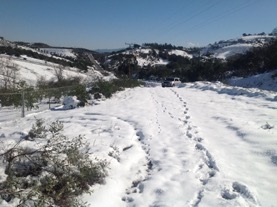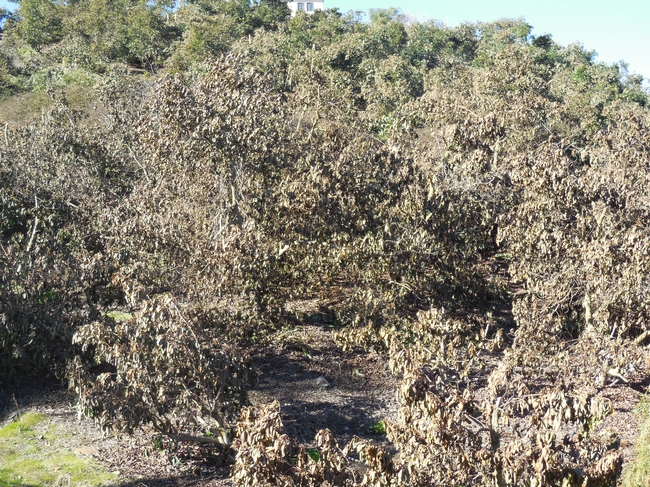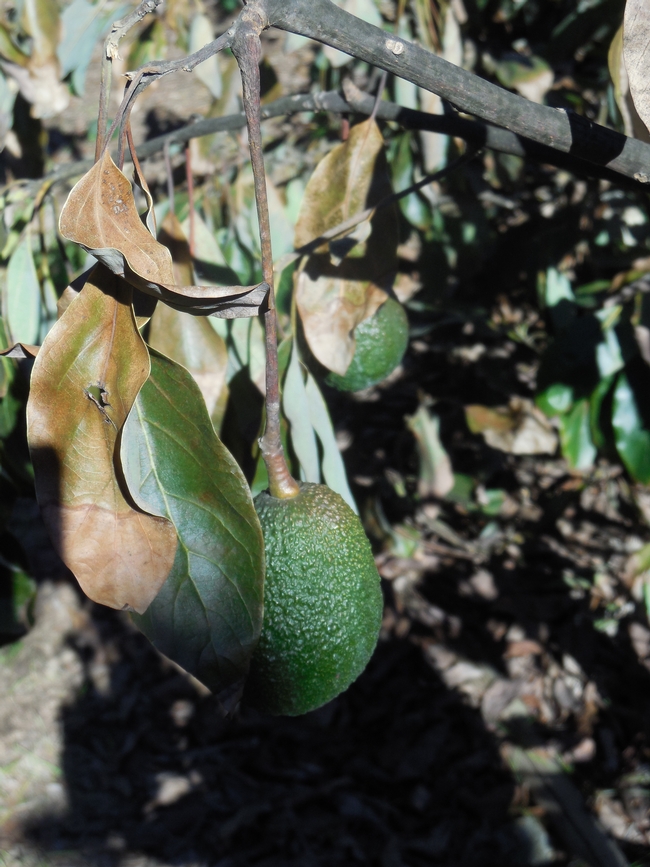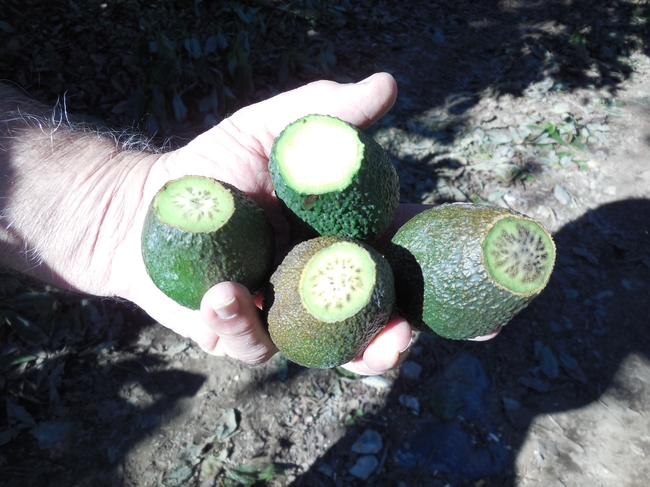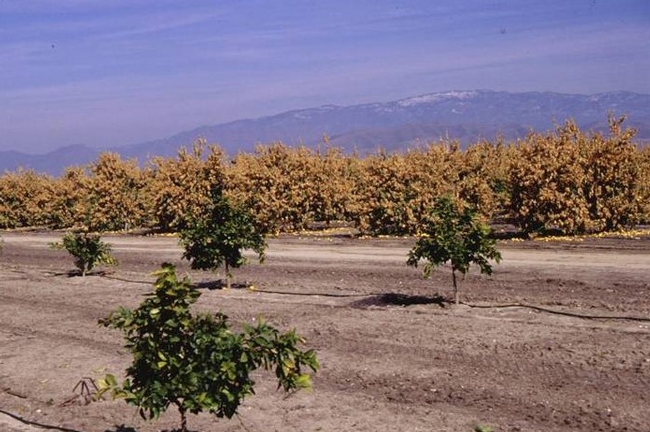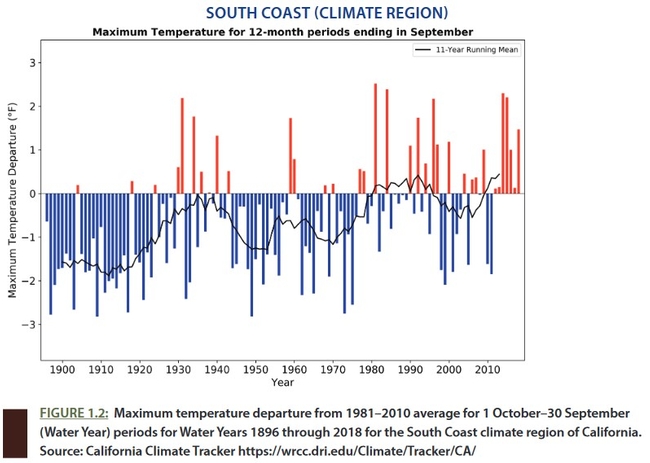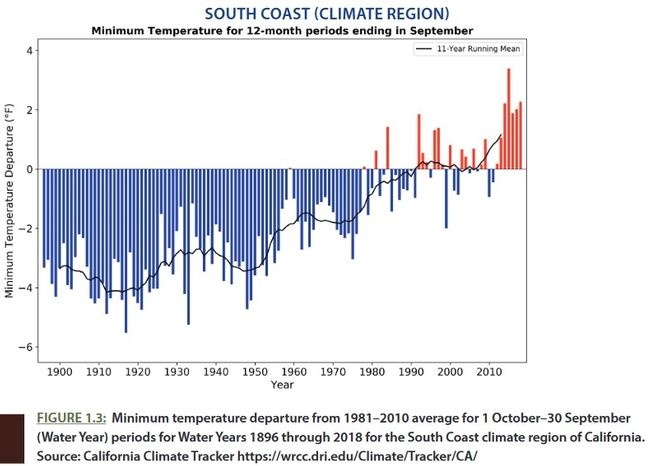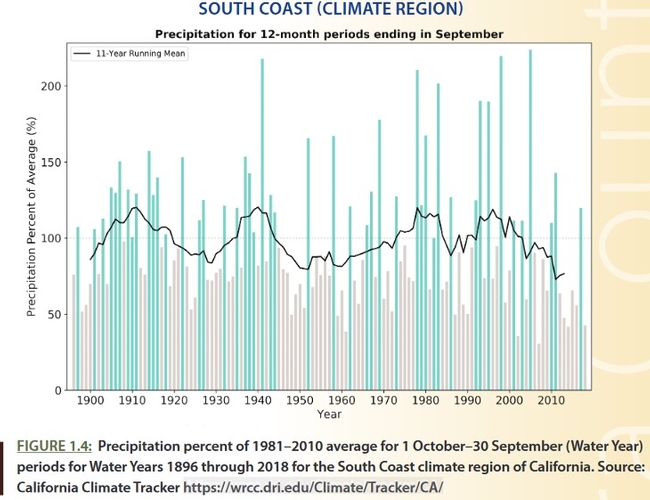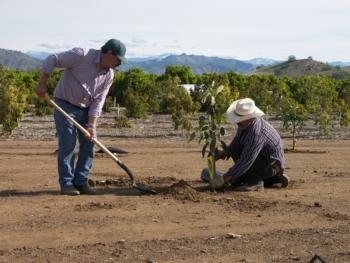
Posts Tagged: cold
Avocado Growers Gear up for the Cold - What Challenges will growers face this Season: Snow, frost, or Freeze?
More than 6 inches of snow fell on areas of Riverside County, part of the state's southern-most growing region, which produces nearly half of the nation's avocado supply. As much as a foot of snow fell on mountain ridges around Temecula and Murrieta the higher elevations of the De Luz area and surrounding region of San Diego and Riverside counties in late December 2014. The accumulation of snow snapped many limbs and branches. The cold and snow also damaged a significant amount of fruit. The De Luz area near Temecula was hardest hit in the higher elevations. It seemed. As if the storm blew in from the East. In some groves lost was estimated 80-90 percent and others we lost nothing. Over the next several weeks, some fruit on the trees turned brown or bronze indicating that it was also unmarketable.
Frost vs. Freeze
The avocado tree, while quite adaptable to a range of climatic conditions, is considered to be sensitive to frost. Growers in regions where frost is likely will need to consider this when designing the layout and irrigation of their orchard. It's important to differentiate between a frost and a freeze. There is a lot of science behind frost, but in basic terms, frost is the formation of ice crystals on plants which more importantly can lead to the freezing of internal sap. Frost is the result of climatic conditions that lead to sub-zero temperatures. A frost is caused when objects cool during the night and radiate their heat loss, chilling the surrounding air. Cold air tends to settle near the ground while warm air rises. In Southern California, the “ceiling” is often low, which means that warm air is closer to the ground. This phenomenon is called a temperature inversion and it tends to protect orchards from the cold. That said, when forecasts indicate windy conditions this disrupts the inversion and thus the colder air is pressed to ground level. Knowing whether a temperature inversion is present or not is a key factor in determining whether to use wind machines as a preventative measure.
A freeze occurs when a mass of cold air moves in and the temperature of the air decreases at both ground level and in the higher air levels. Protecting groves in these conditions is difficult and usually involves adding heat to the grove with orchard heaters. When grove temperatures are cold (generally below 60-degrees Fahrenheit) and the day is sunny, avocado leaves can stress and bleach or yellow because they cannot metabolize the light being received in such cold temperatures. The leaves produce hydrogen peroxide, which damages the leaves.
For California avocado growers, January is the month that groves tend to be susceptible to frost and freeze damage. As the threat of colder weather arrives, it's important for growers to understand the mechanics of frosts and freezes, and what they can do to protect their groves from unseasonably cold conditions. Be aware of temperatures falling below 30-degrees Fahrenheit, regardless of weather forecasts. Rather than rely on forecasts, establish a frost-management plan, and follow it.
Protecting Groves
To prevent frost damage in a mature grove, the two most-relied-upon methods are orchard heaters and wind machines.
As a guide to inexperienced growers, Table I gives a basis for establishing frost protection practices. The critical temperatures listed are for mature healthy trees. Other tree conditions might move these figures one or two degrees higher. Also, the duration of the damaging temperatures would affect the degree of injury.
|
Variety Frost Resistance |
||
|
Race |
Typical varieties |
Critical temperature below which fruit and/or trees are subject to damage |
|
Mexican |
Duke, Topa topa, Mexicola, Zutano, Bacon |
25 Degrees F |
|
Hybrids |
Fuerte, Puebla |
28 Degrees F |
|
|
Ryan, Hass, MacArthur, Nabal, Endranol, Rincon |
29 Degrees F |
|
Guatemalan (Very Tender) |
|
30 Degrees F |
Orchard heaters tend to distribute heat to all parts of the grove when well distributed but can be expensive to run and can present a fire hazard.
Wind machines are economical and less labor intensive and, when used with orchard heaters, can increase the effectiveness of the heaters. Wind machines should only be used in frost conditions — not during freeze conditions in which temperatures fall 4 or more degrees below damage points. In addition, wind machines should not be used in conditions (usually windy) in which no temperature inversion is present. If wind machines are used in these conditions, they can cause more damage because they simply stir up the cold air at tree level.
In situations in which there is no temperature inversion, the best practice is to run microsprinklers during the day and then turn off the water prior to sunset. As water freezes it gives off heat, so by providing water to freeze, you are generating heat. However, water cannot flow when it is frozen, so any under-tree irrigation systems must be started before the temperature gets to a point when the water freezes in the pipes or emitters. If temperatures drop below 32° during the night, the water should be started again and run until sunrise. Since it can be expensive to run water in San Diego County, growers can opt to choose those portions of their grove that tend to be the coldest in order to save money. When the temperature is below freezing, Dr. Faber recommends against running water in a block during the night and then turning it off to water another block as this will lower the temperature in both blocks and lead to damage. It should be noted that these methods are less effective for protecting young trees. To protect young trees, insulative wrap or frames with a burlap cover may be needed. Side and top cover is required to protect from frost, trunk guards can help prevent total tree death by protecting the main trunk.
Location, location, location! Choose a good growing location to minimize the chances of cold air. Cold air is heavier than warm air, so planting on a slope allows cold air to flow down and out of your groves. It is important to have space available for downhill air drainage of cold air. Trees that are planted more towards this area are more prone to damage, especially when the trees are young (up to 3 years of age) or if they have cold-sensitive cultivars. Orchard design is another important factor, aligning your rows to run up and down slopes rather than across slopes to allow effective air drainage. Cultivation practices can also help with battling frost. Maximizing tree health can also be beneficial for a grove susceptible to frost, a healthy, leafy tree will generate some internal heat and reduce the depth of frost burn into the tree. Unhealthy trees should be treated for root rot at the beginning of spring. If not properly treated, these trees will flower excessively in spring; but fail to grow new shoots. If the leaves yellow during winter, consider reviewing your nutrient program. Weed control is an important pest management routine that should be taken seriously. A strip of bare, moist earth under and around the trees will absorb and release heat more than a weedy or dry site.
Occasionally avocado trees are in a growth flush (a period of rapid new growth) when freezing temperatures occur. This is not usual, but unseasonably warm weather may stimulate a tree into abnormal growth in the winter. To avoid stimulation, pruning should be delayed until early spring. When tender growth occurs in the winter, growers may have to provide additional protection or sustain damage.
Caring for Frost Damaged Trees
Immediately after a frost event the main thing to do is carefully monitor your soil moisture. As the tree may have been significantly damaged, the amount of water it will be using will be reduced. The last thing you need is to damage the root system as well through waterlogged conditions. Trees stressed by wet soils may have premature leaf drop, bear small and pale green leaves, and show signs of avocado shoot die back. Too much water during this time can cause root rot. If trees lose leaves to frost/freeze, it's important to protect exposed branches from sunburn with whitewash. Initially all you can do is to let the trees start to recover naturally. Once they have started to re-shoot in spring, then you can begin the task of removing dead wood and shaping/balancing the tree.
Post Freeze Grove Management and Harvest
According the California Avocado Commission (CAC), after a freeze, California avocado growers should look for the following freeze indicators:
- Firm, brittle, curled leaves
- Water-soaked or discolored wood or twigs
- Older branches and trunks splitting and losing bark (this happened a lot during the snow event in 2015)
- Discolored avocados, with hues ranging from barely visible bronze to black
- Brown buds and flowers
- Fruit stems can be killed or ring barked, causing heavy-fruit drop
Soon after leaves fall, whitewash defoliated trees with white-latex or lime-based paint that is water diluted (not too diluted, as paint should appear white on tree). This will protect damaged wood from sunburn, which can cause further damage. Do not apply dressings — or additional paint-on sealants — to cracked bark, as it might strengthen bacterial or fungal infections. Pruning can be postponed until spring or summer, when new growth develops. Survey damaged trees before applying fertilizer, to identify what minerals are lacking, as nitrogen applications are likely to trend downward. It is suggested that avocado growers withhold nitrogen fertilization until midsummer (or longer). However, zinc sprays often are applied to expanding young foliage.
Stem-damaged fruit will drop within seven to ten days of a freeze, it should be picked first, assuming it is mature and not otherwise harmed by the cold. While stem damage may be apparent, fruit might be unscathed. When stems are completely girdled by a brown band, fruit will drop. Drops typically occur within seven to 10 days, following a freeze. Also, do not pick any discolored avocados (barely visible bronze to black).
Work Cited
- California Avocado Society. The Weekly Newsline: Market news, opinions & Statistics for Avocado growers. [http://www.californiaavocadosociety.org/] Accessed 7 January 2015.
- Dreistadt S. H. (2008). Integrated pest management for avocados (Vol. 3503). UCANR Publications.
- Witney, G. W., & Arpaia, M. L. (1991). Tree recovery after the December 1990 freeze. California Avocado Society 1991 Yearbook, 75, 63-70.
Valley Lemons?
What about Planting Lemons in Kern County?
By Craig Kallsen, UC Cooperative Extension Advisor, Kern County
Kern County is located at the southern end of the San Joaquin Valley of California. Over the past couple of years, I, as the citrus Farm Advisor for the University of California Cooperative Extension in Kern County, have received an increasing number of enquiries about the feasibility of growing lemons here. The answer is “yes” we can grow lemons here and according to the latest Kern County Agricultural Commissioner's Report (2017) we have 4010 acres of bearing and 10 acres of non-bearing lemons in the county. Those 10 acres of non-bearing lemons indicate that fairly recently someone decided lemons were the way to go.
These inquiries as to the feasibility of growing lemons are understandable. The price and demand for lemons in the U.S. and worldwide is increasing. Depending upon where you get your statistics the retail prices of lemons was something like $1.50 per pound from 2011- 2013 to something like $2 a pound from 2015 – 2017. The statistics show 2018 was even a better year for selling lemons. Consumption of lemons in the U.S. was less than 1 million metric tons in 2011 to about 1.25 million metric tons in 2017. Worldwide consumption has increased from about 4.5 million metric tons in 2011 to 5.5 million metric tons in 2017. If you add in other factors such as a heat wave, which, for example, hit Ventura County production hard in July 2018, or extreme winter freeze events, and sometimes-erratic supplies from other lemon producing areas of the world, prices can skyrocket 40% or more in a month. Being able to sell a carton of lemons for excess of $55 can be very attractive to prospective growers. Not surprisingly, if you compare the cost and returns of growing lemons with those of oranges, a person might wonder why anybody would choose producing navels over lemons (see https://coststudies.ucdavis.edu/ ).
Planting lemons is riskier. In the San Joaquin Valley, the major consideration is the greater frost sensitivity of lemons as compared most other citrus crops. Not only do lemons freeze at a higher temperature, so do its branches. A freeze, which can spoil orange or mandarin production for a year, can devastate lemon production for three years due to increased damage to the lemon canopy and the older branches of that canopy. If your tree freezes back to the major scaffold branches, you are out of business for a while. An important question is how often does it cold enough to destroy my lemon production capacity for three years or more? Industry wide, for the last 30 years we have had three freezes where lemon leaf canopies, even in the warmer areas of Kern County, were severely damaged – December 1990- January 1991, December 1998, and January 2007. Not to be an alarmist but, in looking at these dates, it would appear that we may be overdue for an extreme freeze. We flirted with one in early December of 2013. Over the years, I have noticed that as the time interval increases from the previous frost event, citrus orchards move further and further down onto the valley floor, only to retreat to higher ground after the next severe event.
Well, what about global warming? Shouldn't Kern County be getting to be a safer place to grow lemons? In answer, predictions can be difficult, and according to baseball legend Yogi Berra, this is especially so if they are about the future. Winter air temperatures have been climbing over the past 30 years in the southern San Joaquin Valley. With our Mediterranean climate in the SJV, most of our rain falls during the fall and winter. Drought years, which means drought winters, have become more common. The higher winter temperatures are good news for citrus growers, but the droughts have been bad news in that dry air in not conducive for fog formation. Fog, historically, is our winter blanket, that holds temperatures above freezing when conditions are ripe for rapid drops in temperature associated with clear, windless nights following cold fronts that move into the valley from Alaska and other points north.
The risk in growing lemons can be mitigated. As with any real estate endeavor, the three most important factors governing the value of a prospective lemon property are location, location and location. When we are talking about cold temperatures, we are talking about nighttime low air temperatures. Daytime winter temperatures, once we get into mid-morning, usually, are more than warm enough to keep lemons from freezing. The major mitigation factor under human control is to plant lemons in the areas of Kern County that have the warmest nighttime temperatures. These areas tend to be on the lower slopes of the foothills on the eastern and southern areas of the SJV. Cold air is much heavier than warm air and runs like a river downslope. Good cold drainage is necessary. If lemons are planted too far out onto the valley floor, they end up at the bottom of a lake of cold air during late fall and winter freeze events. The area where citrus is grown, often, is referred to as a belt along the lower foothills of the SJV. Not only is this belt characterized by more fog than higher up in the foothills, but also it is close to the atmospheric inversion layer that forms in the SJV during the winter. The SJV is at the bottom of a large deep bowl formed by surrounding mountain ranges, and the depth of this bowl makes the air more difficult to disturb by wind. This still air, on cold, clear nights during the winter, allows heat radiating into the sky from the ground to warm a layer of air, usually located from 500 to 1000 feet above the valley floor. The idea of using wind machines successfully is to move this layer of warm air down to the trees on the ground. If you are down on the valley floor, on most nights the warmer air is way too high up to bring it down to the ground with wind machines. If an orchard is 500 feet above the valley floor on the side of a foothill, you might already be in the inversion layer and won't even need to start your wind machines, or at worst, the inversion layer is close enough to bring that warm air down to the trees with wind machines. Unfortunately, the amount of land winter-warm enough for growing lemons in the foothills is very limited, and, currently, is occupied by other crops, probably citrus. We cannot grow lemons too high up in the foothills, because these areas are above the inversion layer and winter temperatures there will always be too cold for lemons. Kern County, in general, appears to be colder than its neighbor Tulare County to the north, and usually suffers more in terms of fruit and tree losses during extreme frost events.
Those bold enough to grow lemons appear to have more choices on which lemon to grow now than in the past. Some newer seedless or lower-seeded lemon varieties are available (https://citrusvariety.ucr.edu/ ). The Lisbon lemons, of which there are several selections, is an old Kern County standby, and appears to have better frost tolerance than the Eureka, commonly grown in the central and southern coastal areas. The Improved Meyer lemon is a hybrid, apparently, with citron, mandarin and pummelo heritage, and has excellent frost tolerance. However, the fruit does not hold up well on the tree, in storage or ship very well, and few commercial groves exist. It remains a very popular and successful backyard tree for homeowners.
With the threat of the Asian Citrus Psyllid (ACP) and the Huanglongbing disease it spreads, the feasibility of growing citrus under protective screens (CUPS) is under investigation. These protective screens, in addition to keeping ACP out, would likely provide additional frost protection as well.
The other obvious concern related to the number of enquiries I have received, is that even if lemons are not widely grown in Kern County now, worldwide demand suggests that there are likely many new acres of lemons in the ground now or in advanced planning stages in other locations in California, Arizona and the world. In the past, we have seen the acreage of a number of crop commodities rise and fall with the laws of supply and demand. We have planted and then pulled lemons in Kern County before based on market conditions. At some point, even unfrozen lemons will not sell if there are too many out there.
Figure 1. Frozen mature lemon trees in photo background, after the 1998 freeze in the Edison area of Kern County. Juvenile, undamaged navel orange trees in foreground (photo by Craig Kallsen).
Which Way Weather?
In 2018 the Ojai Valley Land Conservancy (OVLC) accepted a grant from the Resources Legacy Fund on behalf of Watershed Coalition of Ventura County (WCVC) for a study of projected climate changes in Ventura County. OVLC contracted with Drs. Nina Oakley and Ben Hatchett, climatologists with the Desert Research Institute (DRI), to evaluate historic climate variability and projected changes in Ventura County. This information is needed to “paint a picture” of future climate in the watersheds of Ventura County (Ventura River, Santa Clara River, and Calleguas Creek) to support and inform climate change-related decision-making. This study provides important information for the amendment to WCVC's Integrated Regional Water Management (IRWM) Plan
You can find a copy of the report on the DRI website at: https://wrcc.dri.edu/Climate/reports.php.
To view presentations and other information from the two WCVC Climate workshops conducted with Drs. Oakley and Hatchett in October of 2018, and April of this year please visit: http://wcvc.ventura.org/documents/climate_change.htm
Some of those most interesting findings for me, are the historical data. For example, data for the years 1896 – 2018, show a tendency toward increasing maximum temperatures over the period, especially the last 10 years (Fig 1.2). But most interesting, is the increasing minimum temperatures (Fig 1.3) as compared to the maximum temperatures. Winter where is thy sting? The 2018-19 winter was the coldest in my memory, with the heater on full time at night, but there was no general frost damage this year. I can remember 1990 and 2007.
Precipitation in the South Coast region exhibits high interannual variability over the period examined. No notable long-term trends are observed (Fig. 1.4). Since approximately 2000, the 11-year running mean decreases, associated in part with the 2012–2019 drought. It is unclear whether this trend will continue in subsequent years.
There's a lot more information in the report. READ On.
But something to keep in mind, is that we had a terrible heat wave last July, and it could easily happen again. Growers who had their trees well hydrated before the heat arrived, sustain less or no damage to the trees and much less fruit drop. Trees that were irrigated on the day it started to get hot, never had a chance to catch up with the heat. Once the atmosphere starts sucking the tree dry, water movement through the soil, roots and trunk cant keep up with the demand. Weather forecasting is pretty accurate 3 days out, and if heat is forecast, get those trees in shape. You can run water to reduce the temperature and raise the humidity in the orchard to reduce transpirational demand which helps some.
Something we learned last year. What we saw and what to expect:
https://ucanr.edu/blogs/blogcore/postdetail.cfm?postnum=27676
Map of elevational changes in Ventura County and how
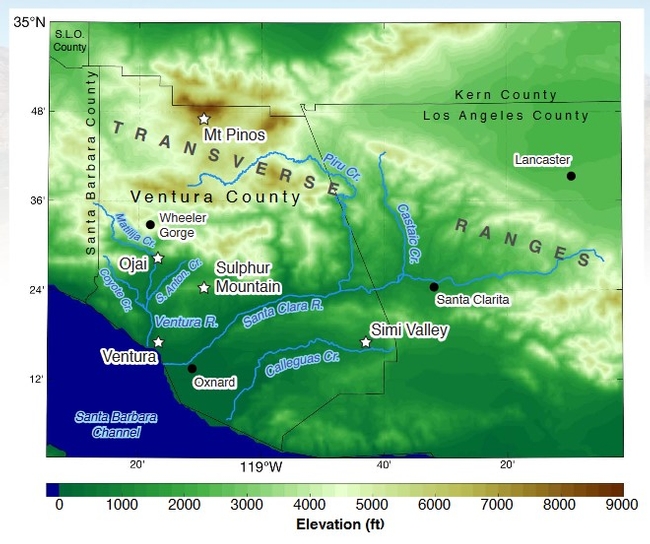
elevation ventura
Central Valley Avocado Meeting
Interested in San Joaquin Valley Avocados?
When: NOVEMBER 28, Tuesday, 1PM
Where:
UC Lindcove Research and Extension Center Conference Room (22963 Carson Ave, Exeter, CA 93221), Central Valley.
Tentative Program:
Welcome and Introductions – Mary Lu Arpaia, UC Riverside
Challenges to growing avocados in the Valley
Irrigation, Fertilization and Soil Requirements – Ben Faber, UCCE, Ventura County
Avocado Root Rot and how to manage – Greg Douhan, UCCE, Tulare County
What is the California Avocado Commission and the Hass Avocado Board? – Tim Spann, California Avocado Commission, Irvine, CA
Results from the Tier 3 varietal evaluation block at UC Lindcove REC – Mary Lu Arpaia and Eric Focht, UC Riverside
Ideas for the Valley Avocado Industry – Group Discussion
Walkthrough of the Tier 3 varietal evaluation block
RSVP to Diana Nix (dlnix@ucanr.edu)
For more information contact Mary Lu Arpaia (mlarpaia@ucanr.edu)

avocado cluster
Cold Nights in Ventura
By way of Ventura grower Sandy Hedrick. This is a compilation of nights of "firing" done by Farm Advisor Bob Brendler from 1923 to 1988 that was collected by Terry Schaeffer of The Fruit Frost Service. Can you imagine over 70 nights of freezing temperatures when the smudge pots had to be lit? Now we don't normally "fire" the pots, but use water and wind more commonly. And it's only for a few nights at the most during the winter. In the "old" you couldn't plant avocado or lemon east of Sycamore Rd, just east of Santa Paula. Now there are avocados planted in Fillmore. And apple bloom erratically out there for lack of chill hours. And in summer it's getting too hot to grow strawberries even on the coast because with temperatures above 80 deg there is poor pollination.
Brendler loved weather information and irrigation issues. He was the first person in the Ventura office to use a computer and he was the oldest Advisor in the office at the time. The weather data chart was the first type of chart that could be done on a computer.
Do you think something has changed? By the way Terry is still running a private weather service for growers in Ventura.
Click on the link: Temp Chart002
X

cimis

Temp Chart003

